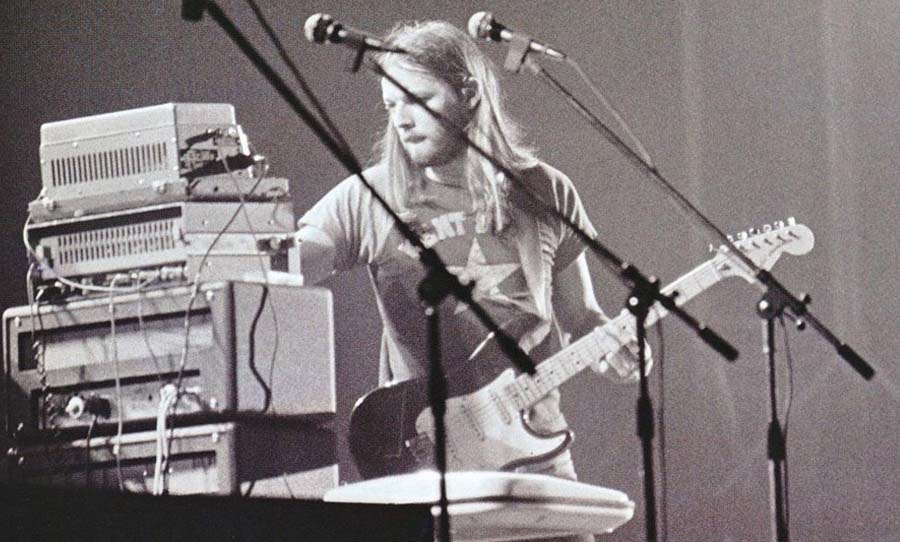Over rock music’s long and lustrous history musicians have adopted effects to complement their playing. And with the ability to add unique tones and flavours to a guitar sound, effects have at times become crucial to artist’s sonic aesthetic, shaping their trademark sound.
Here we look to explore a few effects that have been vital to the sound of artists for a significant period in their careers, and delve into the unique was in which they were used.
From David Gilmour’s wailing tones to the wall of white-noise created by The Jesus and Mary Chain’s Will Reid, we dive into 6 effects that defined the sound of 6 iconic guitarists.
Jonny Greenwood (Radiohead) – BOSS/Roland RE-201
Roland’s original Space Echo RE-201 touched down in 1974, featuring magnetic tape loop effects that were capable of creating astounding celestial sounds. The unit boasted 11 different repeating modes, each formed by combining the multiple playback heads.
The unit also incorporated a spring reverb, separate mic and instrument inputs and controls for EQ, delay speed, intensity and wet/dry and mix. The result was a highly customisable delay that could produce a smorgasbord of dreamy tones.
Perhaps most unique aspect of the Space Echo was its ability to burst into wild and untamed oscillation effects by manipulating the tape speed and intensity controls. Compared to other delay units of the time, it was robust and relatively portable, making it a workhorse for both touring musicians and studio applications alike. The RE-201 has been a classic across numerous genres, spanning from psychedelic rock to dub.
Not shy to using stompboxes, Radiohead’s Jonny Greenwood could be characterised by any number of pedals. However, he is one of the most accomplished and prolific users of the Space Echo. The unit was a vital part of Greenwood’s touring rig and can be heard extensively in the 1997 album, OK Computer. He would place the RE-201 at the end of his extensive effects chain, before running into his VOX AC-30.
The lead lines of Subterranean Homesick Alien showcase the Space Echo’s characteristically warm delay, with each repeat delicately changing pitch and definition (thanks to the liberal use of a Digitech Whammy and DOD envelope filter). The chorus incorporates a thick wall of oscillation, sounding a lot like an otherworldly space-craft, fitting nicely with the songs thematic persona.
On In Limbo from 2000s Kid A, Greenwood also delves into dramatic oscillation sounds for the song’s frenetic finale. On the other end of the spectrum, he uses his RE-201 to provide depth to the opening sequence with some soft arpeggios.
Greenwood continued to use the Space Echo throughout Radiohead’s extensive discography, the ethereal lead playing on 2007’s House of Cards being another notable example.
In 2010, Boss released the RE-20, a digital replication of the 201 which incorporated all of the original functionality of the Roland original in a much smaller package. You’ll find the RE-20 on Greenwood’s pedalboard these, no doubt adopted for practicality’s sake. For the average delay fanatic, the RE-20 also costs a fraction of the original and comes with the added bonus of not having to maintain the costly moving parts of an analog tape delay.
Robin Trower – Shin Ei/Univox Uni-Vibe
The warbling effects of a vibe pedal are perhaps the pedal world’s happiest accident. Launched in the 1960s by Japanese company Shin-ei, the unit intended to bring the sound of a Leslie to electric organs and guitars. Audio engineer Fumio Meida set out with the intention of replicating this “Doppler” like effect by using four light bulbs to create a staggered filtering system.
The result was defiantly not a Leslie, but it wasn’t quite a chorus or a tremolo. It was something completely new in its own right. The effect became known as a four-point phaser and produced a liquid hypnotic pulse, unlike any modulation effect of the time.
Upon its 1968 North American release by Univox, the Uni-Vibe was adopted by the more experimental artists of the day, who craved a unique spice for their tone. Jimi Hendrix was early to adopt the effect, one of the first examples being his rendition of Star Spangled Banner at Woodstock and later Machine Gun with the band of Gypsies. The Univibe was also integral to David Gilmour’s sound, making its debut in 1972 and featuring heavily on Dark Side of the Moon.
If Gilmour and Hendrix were the pioneers of the Univibe, Robin Trower was the master, taking the combination of a Stratocaster, Marshall stack and Uni-Vibe to the next level. Building on the sounds of these rock ‘n’ roll heavyweights, Trower began to use the Uni-Vibe in the pursuit of his solo career. His 1994 breakout album Bridge of Sighs was slathered with the effect.
Trower used his Uni-vibe to create subtle flavours on the songs Too Rolling Stoned and Day of the Eagle. However, it’s the album’s title track that best displays the soupy goodness of the effect, with the rotating pulse perfectly synched to the tempo of the song.
The slow and moody blues riff throbs percussively along with bouncing bass line. Legendary Beatles engineer Geoff Emeric produced Bridge of Sighs and used three microphones (amp, midfield and room) to capture the full depth of the Uni-Vibe. Trower also used an expression pedal to control the speed of the unit and would wedge a perfectly-cut woodblock under the pedal to set thumps for certain songs.
These days, Trower uses a Fulltone Deja Vibe with a custom expression pedal. Fulltone’s replication boasts the exact circuit as the original, without the thousand dollar price tag.
Tom Morello (Rage Against the Machine) – Digitech WH-1 Whammy
Originally manufactured by Digitech in 1989, the WH-1 Whammy was like no effect before it. Part pitch-bender and part octave-shifter, the Whammy offered 16 preset settings: five Whammy effects, nine Harmony effects and two Detune effects.
The pedal allowed the user endless expressional possibilities with a foot pedal that controlled the expression of each function. The interactivity and ease of manipulation encouraged users to create dramatic and intense sounds which are unmistakably Whammy.
The pedal has been extremely popular since its introduction, however, most artists have used it sparingly, it has the habit of completely taking over one’s sound. Jack White is perhaps an exception. He carefully blends the effect with his guitar and amp to create a more natural sound.
The Whammy simply magnifies his playing. A great example of this being the untamed lead segments on Ball and a Biscuit or the subtle octave-down tone on Seven Nation Army that cleverly imitates the sound of a bass guitar.
Tom Morello differs in that many of Rage Against the Machine songs have Whammy parts, where he adopts and embraces the unhinged tones to creative effect. He is a master of using the pedal to highlight expression, not only to intensify solos but also to add unique textures to the songs. Perhaps the most famous example is the solo from Killing in the Name, a pioneering recording of the WH-1.
Morello tames the anomalous whirring into an unpredictable yet musical tone, the octave up function piercing through the mix with every pedal sweep. On tracks such as Calm Like a Bomb, he uses this octave up function texturally, with gradually ascending notes complimenting the main riff. Bullet in the Head and Know Your Enemy both include a tone akin to an organ or synth, formed using the Whammy’s 5th-note function.
The Whammy is currently in its fifth generation and Morello to this day uses a Whammy DT with his project Audioslave.
William Reid (The Jesus and Mary Chain) – Shin-ei Fuzz-Wah
The Shin-ei corporation is no stranger to experimenting with unusual effects, having produced the (originally) novel Uni-Vibe as well as a range of unique fuzzes. Early dirt boxes in their range featured germanium transistors which produced a thick and warm tone. However, because of natural gating in the circuit, the units were often quiet, even with the gain and volume cranked.
Towards the end of the 60s, manufacturers such as Shin-Ei and Dallas Arbiter (who created the Fuzz Face), endured a shortage of germanium transistors, leading them to turn to silicon alternatives. Silicon had the advantage of being more stable under varying temperatures, however the sound was louder, heavier and harsher.
For The Jesus and Mary Chain’s William Reid, this was the main appeal of the Shin-Ei Fuzz-Wah.
In its early days, the band, formed by the Reid brothers, drew heavily on punk and proto-punk influences such as The Velvet Underground, Iggy Pop and the Ramones. But the duo sought to distinguish themselves with a new sound, wherein a noise-heavy element was established.
The main tool for this unhinged sound was William’s Shin-ei Companion Fuzz-Wah, and by many reports, a broken unit at that. This pedal alone was the key to the band’s early sound and their debut album, Psychocandy.
Will Reid often used semi-hollow guitars, such as the Gibson 330 or Guild Starfire, which was already prone to feedback. With the Shin-ei fuzz cranked, he manipulated this noise with the guitar’s vibrato, as well as its proximity to his amplifier. The Fuzz-Wah could also be cocked to create unique tones within the fuzz itself, from a shrill fizz to a blistering chainsaw.
Taste the Floor, displays the Shin-ei Fuzz-Wah in all its glory, with the main chord progression almost approaching white noise. During vocal interludes, a second guitar can be heard screeching into the mix with a brutal feedback that eventually blends with the first, creating a brutal wall of sound. Without the Fuzz-Wah (which appears on every song on Pychocandy), it’s hard to imagine The Jesus and Mary Chain becoming the revered noise pioneers they are hailed as today.
Like many of the pedals in this list, the original examples of the pedal are rare and pricey, however, for a keen noise enthusiast looking to emulate the Jesus and Mary Chain sound, the Dunlop Jimi Hendrix Fuzz-Wah provides similar tone and functionality, with little damage to the wallet.
David Gilmour (Pink Floyd) – Binson Echorec
The gleaming gold housing of the Binson Echorec makes it look more coffee machine than delay effect, and perhaps that is expected from a mid-century design from Milan. From the 1950s, Binson crafted some of the most unique and obscure delay units the music world had ever seen. Unlike other delay units of the time, such as the aforementioned Space Echo, Binson units featured rotating magnetic drum recorders, driven by an AC motor, which gave their repeats a unique metallic, modulated sound.
The Echorec was a relatively complex device, with the drum spinning over four playback heads and running through six preamp tubes. There was no control for delay time, however different combinations of the four playback heads provided ample customisation as well as unique rhythmic repeat patterns. The unit possessed three delay settings: Echo, for slapback sounds, Repeat, for standard delay and Swell which mixed and blended the sound for a reverb-like effect.
An early adopter of the Echorec was Hank Marvin of the Shadows, who employed the device for its metallic slapback sound in the early 1960s. As the psychedelic era progressed, musicians began to see the potential to create otherworldly ambience and artists such as Led Zeppelin and Hawkwind began experimenting with the unit’s potential.
It also became a staple of Pink Floyd’s early sound, with original frontman Syd Barret using the Echorec to create experimental soundscapes. When David Gilmour filled Barret’s place in 1968, he continued with the same setup, taking the Bison Echorec to new heights.
Perhaps the ultimate example of the Echorec’s magic is Gilmour’s solo on Time from Dark Side of the Moon, where the combination of fuzz and echo is both piercing and emotive.
Prior to this, Gilmour and his fellow bandmates experimented heavily with the device, using the repeat patterns rhythmically, as well as the Swell function for haunting textures. Organ player Richard Wright was known to run through the Echorec and bassist Roger Waters also worked extensively with the device. On One of These Days, Waters uses the rhythmic pulse of the Echorec with the cleaner Repeat setting to form a looping bass line.
The richest sonic display of the Echorec can be heard during the band’s Live at Pompeii concert, where Gilmour uses the Echorec throughout, creating long and full lead lines. On Echoes, both Gilmour and Waters create epic atmospheres, especially in the song’s interlude where steel slides are used to create a wind-like sound.
Gilmour eventually moved onto more reliable and programmable digital delays, however, the sounds of the Echorec were vital to Pink Floyd’s early sound and evolution as a band.
The Binson Echorec is one of the rarest effects produced, as it was a small production model and difficult to maintain. Die-hard Pink Floyd fans can rejoice in the fact that digital emulators exist, the Catalinbread Echorec being one of the most successful.
Billy Corgan (Smashing Pumpkins) – Op-Amp Big Muff
The Electro Harmonix Big Muff has seen countless renditions since its inception in 1970. The original ‘rams-head’ circuit became popular in the 1970s for its thick, reliable tone, due to its four transistor design. Its traditional fuzz circuit contemporaries sported a simple two transistor circuit, placing the Big Muff closer to a modern distortion unit.
The Muff’s rich harmonics and sustain made it a favourite for lead players, prominent users including Santana, Frank Zappa and David Gilmour. Towards the end of the 1970s, the unit received an overhaul, ditching the transistors in favour of op-amps, which reduced high-end sustain and produced a characteristic ‘burble’, due to an un-scooped midrange.
The result was a pedal less suited to classic rock solos and more to cutting through a band in a rhythmic context, making it a favourite amongst 1990s grunge and alternative bands.
Smashing Pumpkin’s Billy Corgan was first introduced to the Big Muff after hearing the band Kathrine rehearse in an adjacent studio. Corgan immediately visited his local guitar shop in San Francisco and purchased a Big Muff (which happened to be an Op-Amp pedal) for $75, however, he encountered difficulties when plugging into his Marshall JCM800 stack. The high gain channel proved to be over-saturated and harsh, but after trying the low gain channel with the master all the way up, Corgan was able to use the preamp as volume and find a sweet spot for harmonics.
This proved crucial for 1993’s Siamese Dream, on which Corgan recorded up to six rhythm tracks at a time, each with a differently emphasised harmonic. The combination of thick sub-frequencies and the Op-Amp’s characteristic gritty midrange enabled Corgan to build the thicks walls of sound heard throughout the album.
The main riff on album opener Cherub Rock displays stacked harmonics which form a rich sonic wave, and despite the guitar’s huge presence, the frequencies do not tread on the drums, bass or vocals.
Original Op-Amp big muffs are scarce and expensive, however, Electro Harmonix has reissued the pedal with a small real-estate housing that has all of the charm and functionality of the original.
While you’re here, check out our guide to assembling the ultimate pedalboard:


